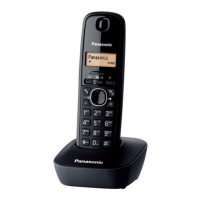Why I cannot use the intercom feature on my Panasonic KX-TG1611 Cordless Telephone?
- MMr. Erik Hicks Jr.Sep 13, 2025
This feature is shared between the handsets. Although the handset displays “Intercom”, this feature is not available for this model.

Why I cannot use the intercom feature on my Panasonic KX-TG1611 Cordless Telephone?
This feature is shared between the handsets. Although the handset displays “Intercom”, this feature is not available for this model.
| Frequency | 1.9 GHz |
|---|---|
| Caller ID | Yes |
| Phonebook | 50 entries |
| Battery Type | Ni-MH |
| Ringer Melodies | 6 |
| DECT | Yes |
| GAP Compatible | Yes |
| LCD Display | Yes |
| Redial Memory | 10 numbers |
| Number of Handsets | 1 |
| Call Waiting | Yes |
| Speakerphone | No |
| Answering Machine | No |
| Intercom | No |
| Expandable | Up to 6 handsets |
| Backlit Display | No |
| Type | Cordless Telephone |
| Number of Batteries | 2 |
| Range | Up to 300 m outdoors, 50 m indoors |
| Power Source | AC adapter and battery |
| Talk Time | Up to 15 hours |
| Standby Time | Up to 170 hours |
| Number of Channels | 120 Channels |
| Ringer Volume Steps | 6 |
Details the base unit and handset models included in the series.
Lists the supplied accessories for the phone models.
Provides critical safety warnings to prevent injury and property damage during product use.
Outlines precautions for safe operation and maintenance of the unit.
Advises on using the product around medical devices and in healthcare facilities.
Gives guidance on safely installing the phone and choosing an appropriate location.
Tips for optimal base unit placement to ensure clear communication and avoid interference.
Recommendations for operating the phone in suitable environmental conditions.
Guidance on how to properly dispose of or transfer the product.
Step-by-step guide for connecting the base unit, line cord, and AC adaptor.
Instructions for correctly installing the rechargeable batteries into the handset.
Important considerations for connecting the AC adaptor and telephone line.
Advice on alternative phone use during power outages.
Tips for handling and installing the rechargeable batteries.
Identifies and explains the buttons and functions on the handset.
Identifies and explains the buttons and functions on the base unit.
Explains the meaning of icons and symbols shown on the handset display.
Instructions on how to power the unit on and off.
Guide to configuring essential initial settings like language and date.
Steps to select or change the display language on the handset.
Procedures for setting the current date and time on the unit.
Instructions on how to choose between tone or pulse dialling modes.
Detailed steps for dialling numbers and adjusting call volume.
How to view, edit, and store numbers from the redial list.
Explanation of the pause function for PBX or long-distance services.
How to answer incoming calls and use the auto-talk feature.
How to set the ringer volume for incoming calls.
Describes functions like Mute and Recall/Flash during conversations.
Information on using Call Waiting and Call Waiting Caller ID.
How to switch to tone dialling for specific services.
Instructions for joining an existing call on another handset.
Steps to add names and phone numbers to the phonebook.
How to modify existing entries in the phonebook.
Procedures for deleting single or all entries from the phonebook.
Using the phonebook to dial numbers during an active call.
Customizing ringer volume and tone for different events.
Adjusting alarm times, repeat cycles, and date/time synchronization.
Managing phonebook entries and viewing the caller list.
Configuring display language, contrast levels, and clock display.
Adjusting auto-talk mode and disabling audible keytones.
Procedures for registering new handsets and changing the base unit PIN.
Selecting dialling mode and configuring recall/flash timing and privacy.
Configuring intercom features and related settings.
Configuring the alarm to sound once or daily at a specific time.
Customizing repeat times and cycles for the alarm snooze function.
Choosing an alarm tone and adjusting its volume.
How the unit displays caller information and handles private/out-of-area calls.
How the unit indicates and manages missed calls.
Displaying stored names when caller ID matches phonebook entries.
Accessing the list of incoming calls and calling back.
Modifying a caller's number before initiating a callback.
Procedures for deleting entries from the caller list.
Saving incoming call details directly into the phonebook.
How to communicate between handsets using the intercom function.
Using the base unit to locate a misplaced handset.
Procedures for transferring outside calls between handsets.
How to transfer a call without prior communication with the receiving handset.
Overview of different modes for entering text, numbers, and symbols.
Solution for the 'Memory Full' error message regarding the phonebook.
Solutions for common problems like unit not turning on or no dial tone.
Addressing problems with a blank or unregistered handset display.
Troubleshooting specific problems related to the intercom function.
Resolving issues with display language or other settings.
Solutions for battery not charging or short operating time.
Troubleshooting issues like flashing indicators, noise, and inability to make calls.
Solutions for missing or slow caller information display.
Correcting time shifts caused by incoming Caller ID data.
Advice on handling liquid damage and drying the unit.
Step-by-step guide to connect a new handset to the base unit.
How to remove a handset's registration from the system.
Instructions for updating the personal identification number for the base unit.
